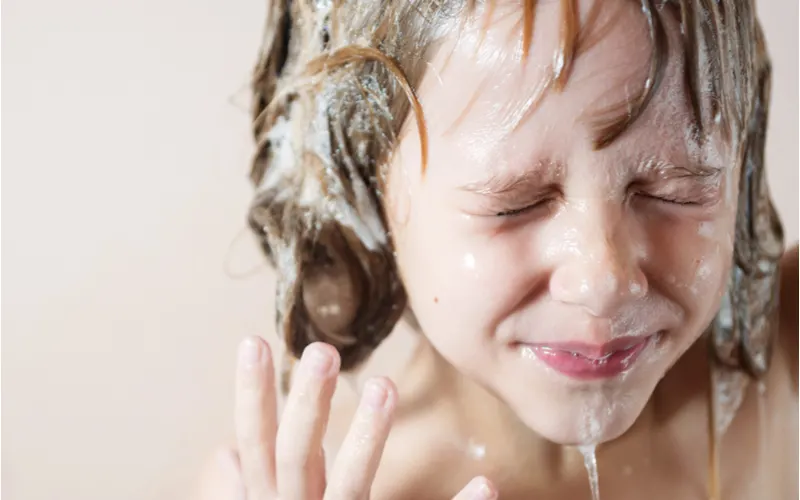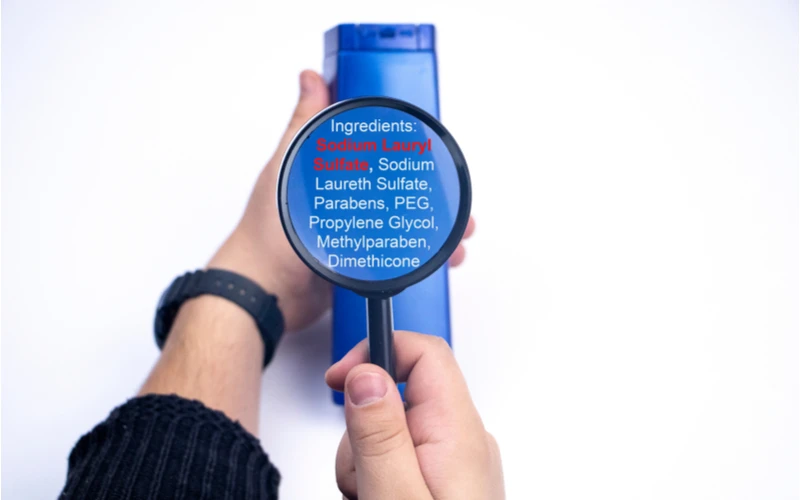Jump to:
You may have heard of tear-free shampoo, and you may wonder what they do differently. What ingredients do they use, and why can’t all shampoo be tear-free?
Since the shampoo cleans as effectively as other shampoos, people often want to know, “What is tear-free shampoo?” Don’t worry — you’re in the right place.
What Is Tear-Free Shampoo?

Olga Mazina/Shutterstock
Tear-free shampoo is made using different surfactants, or cleaning agents, to clean the hair. They are long-chain surfactants, and they are less severe than standard detergents.
They also use a smaller amount in the formula, so it is less likely to cause irritation if it gets in the eyes. The trade off is that tear-free shampoos don’t remove oil as thoroughly, which is why they are generally made for babies.
You may want to understand more about tear-free shampoos, as there is a lot of confusing information out there. People often ask the following:
- What makes shampoo tear-free?
- Do tear-free shampoos contain numbing agents?
- What ingredients should I avoid?
- Does tear-free shampoo clean hair?
We wanted to find the answers, and we did the research for you. Continue reading to learn all about tear-free shampoo and its best uses.
What Makes Shampoo Tear-Free?
When manufacturers make tear-free shampoo, they use synthetic surfactants. Most shampoos use surfactants, which are surface active agents or detergents to clean your hair.
They have the ability to lift dirt, oil, and product buildup, along with other pollutants, off of your hair. They reduce the surface tension of liquids, which allows shampoo to penetrate deeper and spread across the hair and scalp.
Tear-free shampoos use long-chain synthetic surfactants, such as sodium trideceth sulfate or other nonionic polymers. They are gentler and only contain small amounts of cleaning agents.
They don’t include surfactants that can irritate the scalp or eyes. For example, they may use glucosides, which are mild and safe, and they do not irritate the eyes.
Glucose-based ingredients are plant-based, coming from corn, palm trees, wheat, potatoes, and coconut. They don’t contain any petroleum chemicals, so they don’t have these irritating contaminants that are normally associated with other shampoos.
Do Tear-Free Shampoos Contain Numbing Agents?
You may have read that tear-free shampoos contain numbing agents to prevent eye irritation. The rumor is that they contain lidocaine or novocaine, which is what prevents the stinging in the eyes. This is an urban myth that is false. There are no numbing agents in these shampoos.
Clearly it would be dangerous if there were, as there is a possibility of ingesting the shampoo while bathing. If these ingredients were in the shampoo, you would feel a tingling or numbing on your hands when you apply the shampoo.
Tear-free shampoos are not made with any numbing agents; they are made using a milder cleanser that doesn’t cause the same irritation that normal surfactants can cause.
Ingredients to Avoid in Tear-Free Shampoo

Alona Siniehina/Shutterstock
Most of the time, tear-free shampoos are designed for babies. Babies have different needs from adults, as their hair isn’t as thick and isn’t exposed to the same levels of dirt, oils, buildup, or pollutants. They can use a gentle shampoo that is designed to keep the hair clean and healthy.
Any shampoo that contains soap is not going to be tear-free. You should stay away from shampoos that are made with coconut oil, palm oil, or olive oil. These ingredients may be effective cleaning agents and safe to use, but they can irritate the eyes.
There is no danger to using this type of shampoo, but if you want a tear-free shampoo, this won’t work for you. One common synthetic surfactant that does not create eye irritation is sodium laureth sulfate, or SLS.
To manufacture this cleanser, coconut oil is turned into fatty acids, and they use them to derive lauryl alcohol. Then, it is treated with sulfur trioxide gas or chlorosulfonic acid to produce sodium lauryl sulfate.
It is then treated with a carcinogen, ethylene oxide, which makes the final product, sodium laureth sulfate. You may want to avoid this ingredient. People often equate derived from a plant with free of toxic chemicals, and this isn’t always the case. Be sure to consider what you want and choose accordingly.
You should avoid shampoos that contain fragrance, phenoxyethanol, or PEGs because they can cause irritation and contain chemicals. If you want a tear-free shampoo, choose one with natural ingredients.
Read Next: 10 Shampoo Ingredients You Should Avoid
Does Tear-Free Shampoo Clean Hair?
Tear-free shampoo does clean hair, but it isn’t as strong or deep cleaning as other shampoos. However, most of the time, tear-free shampoos are designed for babies and they have different needs.
Babies usually have finer hair and less of it, so they don’t have the same problems with their hair drying out. Their hair usually isn’t as dirty as older children or adults, so they don’t need the same strength of cleanser.
When you use a milder tear-free shampoo, it can effectively clean the hair. It won’t strip the hair of natural oils and other nutrients. It does clean effectively, but it isn’t as deep cleaning as other shampoos.
Frequently Asked Questions
Can anyone use a tear-free shampoo?
Anyone can use a tear-free shampoo, but it may not be as effective for lifting dirt and stronger pollutants from the hair. If you have oily hair or product buildup, it won’t be as effective.
Is tear-free shampoo really tear-free?
While tear-free shampoo doesn’t contain ingredients that will irritate the eyes, the bath water or other things may still cause eye irritation during a bath.
So, What Is Tear-Free Shampoo?
Tear-free shampoo is a gentler form of shampoo that is designed to prevent eye irritation. There are myths surrounding the shampoo because people didn’t know what made it different, but these shampoos do not contain numbing agents; they are simply made with milder cleansing agents.
